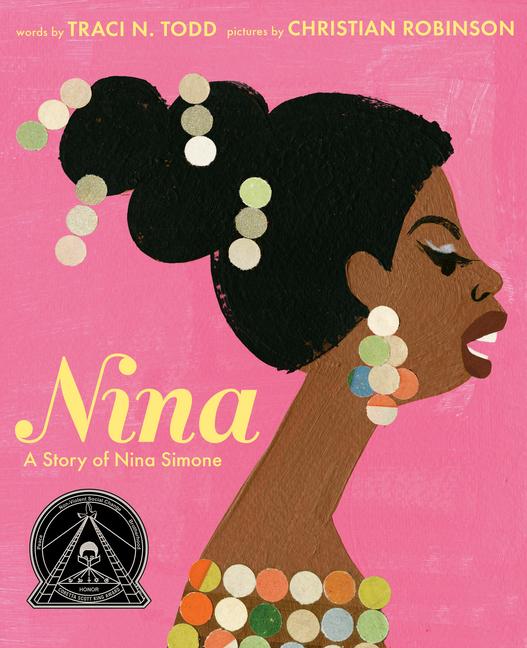Meet-the-Author Recording with Traci N. Todd
Nina: A Story of Nina Simone |
Traci N. Todd introduces and shares some of the backstory for creating Nina: A Story of Nina Simone.
Translate this transcript in the header View this transcript Dark mode on/off
Traci N. Todd: Hi, this is Traci Todd. I am the author of Nina: A Story of Nina Simone, illustrated by Christian Robinson.
I have held onto this idea of writing about Nina Simone for a really long time, I think before I was writer enough. The reason that I wanted to write about Nina for young children is that I had this sense that there was something about her young children should know about. And when I was first writing the manuscript, I really focused on the scene where she was ten or eleven, and she was giving a concert at her hometown library. And her parents had sat in the front row so that they could be close enough to watch her fingers as she played. But before the concert started, her parents were asked to move to the back row so a white couple could sit in the front row. And Nina, who wasn't Nina at the time, she was Eunice, watched this happen. And she was just dumbfounded by it and overcome with confusion and sadness and anger. And she refused to play. It wasn't until her parents were brought back to the front row that she decided to play. And that moment for me had so much in it that a child could relate to, the confusion of seeing your parents removed and not understanding why they're being taken away. The idea of thinking you're having this special day and then having it ruined for reasons that you don't understand. And also just being a small child, being confronted with something as big as racism.
So my very first manuscript was about that scene, and of course it evolved from there. So I think that, in general, music makes some of the difficult things that children need to know about, that we need to talk about, more accessible. And I think the story of how Nina Simone became Nina Simone and how her music became the music of activism is also an accessible story for children.
Christian is brilliant. It was such a gift for him to agree to take this project on. I just was so thrilled. He found so many ways to represent Nina behind the piano and also weave in all the various things that she was going through at the time. So you don't have just these static images of Nina behind the piano, you have Nina behind the piano with protesters, with Dr. King in jail. It's really remarkable the work that he did on this book.
I am going to read from Nina: A Story of Nina Simone, and this is the point at which Nina really leans into her activism. She has fought it for a little while. She wasn't sure if she was going to be an activist, but at this point she knows that activism is her work. It's the thing that she is going to do going forward. And she has written a song that expresses all of her concern for the state of Black America, all of her power and her sadness and her hope for a better future:
Nina's voice broke with the weight of this new music. It was harder now, rough, defiant. Black people loved her for it. They had always loved her, but now as they sat at lunch counters demanding to be served, rode buses demanding to be seated, and marched demanding good jobs for good pay, they knew how much she truly loved them.
The white backlash, however, was swift and fierce. People smashed her records and threatened her life. So Nina sang louder, her voice as steady as the beat of that relentless drum. And when that drum beat sounded on April 4th, 1968 in Memphis, Tennessee, Black people looked to Nina to ease their pain. What will happen, she sang, now that the king of love is dead?
Nina Simone sang the whole story of Black America for everyone to hear. Her voice resounded with the love, joy, and power of it all. And when she sang of Black children, you lovely, precious dreams, her voice sounded like hope.
This Meet-the-Author Recording with Traci N. Todd was exclusively created in October 2021 by TeachingBooks with thanks to Penguin Publishing Group USA.




